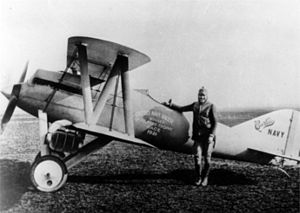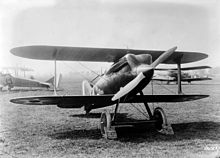Curtiss CR Video - RC Model
|
|
Curtiss CR
Model 23, CR, R-6

Picture - The CR-1 with Bert Acosta, 1921
Role: Racing aircraft
Manufacturer: Curtiss
First flight: 1921
Primary user: United States Navy
Number built: 4
The Curtiss CR was a racing aircraft designed for the United States Navy in 1921. It was a conventional single-seater biplane with a monocoque fuselage and staggered single-bay wings of equal span braced with N-struts. Two essentially similar landplane versions were built as the CR-1 and CR-2, which were both eventually converted to seaplanes as the CR-3 and CR-4. A refined version was developed for the US Army under the designation R-6. This latter aircraft featured refined aerodynamics included surface-mounted radiators.
Operational history

Picture - An Army Curtiss R-6 which won the 1922 Pulitzer Trophy with an average speed of 330 km/h.
The Curtiss CRs enjoyed successful racing careers. Their first major win was at the 1921 Pulitzer Trophy race, where the CR-1 took first place, nearly two minutes ahead of its closest rival, piloted by Bert Acosta with an average speed of 176.75 mph (283.49 km/h). The following year, this aircraft was modified and redesignated CR-2 and joined in the Pulitzer race by a second aircraft built to the same new standard, plus two R-6s flown by Army pilots. These Curtiss aircraft took first through fourth place, the two R-6s followed by the two CR-2s. The race was won by Lt Russell Maughan with an average speed of 205.856 mph (330,172 km/h) with Lt Lester Maitland in second place (198.850 mph/318.936 km/h). Maughan's effort incidentally broke every closed-circuit airspeed record up to 124 mi (200 km). The CR-2s took third and fourth places piloted by Lt Harold Brow (average speed 193.695 mph/310.667 km/h) and Lt Jg Al Williams (average speed 187.996 mph/301.527 km/h).
The Army built upon this success with the R-6s by using the aircraft to break the world airspeed record before 1922 was out, Gen William Mitchell flying one to 224.28 mph (359.72 km/h) on 18 October. In March the following year, an R-6 flown by Russel Maughan lifted the record to 236.587 mph (380.74 km/h).
In 1923, the CR-2s were fitted with floats for the Schneider Trophy race and redesignated CR-3. The aircraft took first and second place, piloted by David Rittenhouse (average speed 177.977 mph, 285.457 km/h) and Rutledge Irvine (173.932 mph, 278.970 km/h). Following this victory, one of the aircraft was further modified as the CR-4 for an attempt on the world airspeed record for seaplanes. It achieved this in 1924 with a speed of 188 mph.
Operators
United States
United States Navy (CR)
United States Army (R6)
Specifications (CR.3 Seaplane)
Data from Curtiss Aircraft, 1907-1947
General characteristics
Crew: 1 (pilot)
Length: 24 ft 8 in (7.52 m)
Wingspan: 22 ft 8 in (6.90 m)
Height: 10 ft 9 in (3.27 m)
Wing area: 168 ft² (15.6 m²)
Empty weight: 2,119 lb (961 kg)
Gross weight: 2,597 lb (1,178 kg)
Powerplant: 1 x— Curtiss D-12 5PL, 450 hp (336 kW)
Performance
Maximum speed: 194 mph (312 km/h)
Range: 281 miles (452 km)
Service ceiling: 22,000 ft (6,706 m)
Comparable aircraft
Gallaudet D-4
Bibliography
Bowers, Peter M. (1979). Curtiss Aircraft, 1907-1947. London: Putnam & Company Ltd.. ISBN 0-370-10029-8.
Taylor, Michael J. H. (1989). Jane's Encyclopedia of Aviation. London: Studio Editions. pp. 796.
World Aircraft Information Files. London: Bright Star Publishing. pp. File 891, Sheet 45.
Curtiss CR Pictures
More aircraft.
Source: WikiPedia